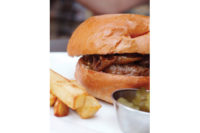Teens and Fast Food Calories Perception

The findings, according to Jason Block, M.D., Harvard Medical School, raise concerns that even when calorie information is available on fast food menus, many patrons still might not make use of it.

|
Block and his colleagues studied teens at fast food restaurants in Boston, Springfield, Mass., Providence, R.I., and Hartford, Conn. The restaurants were visited three times a day for a total of 120 visits during the study. McDonald’s, Burger King, Subway, Dunkin’ Donuts and Wendy’s were some of the chains included in the study.
The mean age of participants was 16; ethnic diversity was fairly equal; and approximately 26% of them were overweight or obese. The researchers made use of the participants’ restaurant receipts in order to calculate the caloric content of their meals, and then administered a short survey.
Although the average calorie count of the meals was 746, 28% of the teens purchased a meal that was 1,000 calories or more. However, the average estimated calorie content was 464. This underestimation was consistent across all restaurant chains.
Even more disturbing, there was an exponential growth associated with greater calorie counts and greater underestimation. In other words, those who consumed 1,000 calories underestimated by an average of 350 calories; those who ate 1,500 calories were 700 calories off the mark.
Only 14% of the participants of the survey noticed nutritional information in the restaurant, and even fewer (3%) used that information when ordering food. This survey is consistent with a similar study conducted in New York City, which found that although most teens noticed the calorie information on menus after such a policy was adopted, only 9% said they considered the information when choosing their food.
The researchers also asked participants to estimate how many calories are needed per day to maintain a healthy diet; 68% were accurate (1,000-3,000 calories), 23% underestimated, and 9% overestimated.
Looking for a reprint of this article?
From high-res PDFs to custom plaques, order your copy today!






